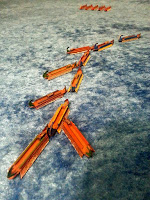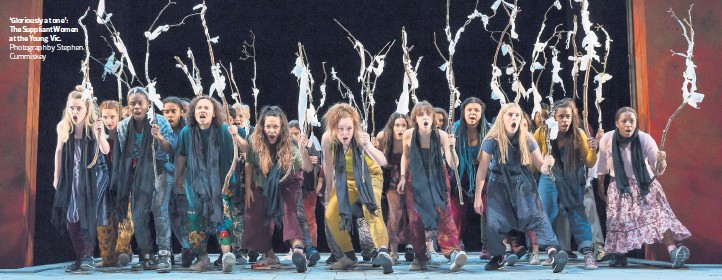Another test battle. Abbreviated.
I tried this to see what would happen with a strong but outnumbered fleet in these rules. Also to use light ships and more with missiles and boarding.
The Seleucids had-
Squadron A 2 Fours 4 Threes 4 Lembus
(here Lembi are dieres/bireme, Lembi were more on a par with a Three than a ship's boat...)
Squadron B 2 Eights 4 Fives 4 Fours
Squadron C as A
Romans had-
2 x Squadron : 5 Fives
1 x Squadron : 1xDeceres 4x Fives with corvus
The Seleucids advanced and sent the light flanks out wide to try and stretch the Roman line.
The Romans opened the right to match the length of the enemy flank. Kept the other squadrons tight.
The flanks meet before the centre and there was an exchange of ships which favoured the Seleucids who had more light vessesls. Even if they meet and lose to a Five then a companion ships comes up and takes the Roman in the side.
The sequence problem reared its head a few times. At this point, for example, the Roman(Red cards) knows he has the next two phases to himself.
The centres come to grips and the heavy ships cannot knock each other out frontally quickly. The Roman flanks are overwhelmed and the Seleucid flanks come in to close the net.
At this point a cat jumped on the table and the Romans ran for home under cover of the chaos.
Seleucids 1 : Romans 0
LESSONS
1) Light ships can still sink heavy from beam attacks. The heavy cannot reply suffciently with missiles to keep them off.
2)Bow-on ramming is nowhere near as bloody as in Poseidon's Warriors. It is about right I think - usually stalemate between equals or heavy ships have upper hand.
3)Manoeuvre is not very decisive. I think limiting turns is needed in addition to separating speeds according to classes.
I used :
Ships up to FOUR can turn 60 degrees in 1 inch.
Ships Five to Six can turn 45 degees
Larger turn max 30 degrees
A contact on a turn inch is a collision not a ram.
IF A SHIP DOES NOT FIT WHERE IT WANTS TO GO THEN IT
CANNOT GO THERE - THIS IS AT THE ACTUAL MOMENT THE PLAYER IS MOVING THE SHIP
This means the sequence a player is choosing to move ships is important. No fudging and saying ' oh, it will fit after they have all moved and it is tidied up'. Ships need space. Big ships need more space.
This means speeds need adjusting too -
Three =6 inches.
It is universally accepted that the Three is the fastest galley it is possible to construct.
Others less than Five =5 inches
Five to Seven = 4 inches
Larger =3 inches
4) Boarding and deck fighting lacks something. A marker is needed for LOCKED and CORVUS.
Multiple combats need a system.
I used...
'Each combat is diced separately. and is simultaneous.'
5)Deck crews/marines : a trireme crew will inflict much more damage on a larger ship's crew if it wins. A step reduction rather than just 'halving' is needed.
I used...
'Crew hits give -2 to Marines strength and Shooting Strength. Not to Artillery.'
6)Artillery and shooting. It seems odd to have different Shooting and Marines factors. The argument for a concise set of rules should support a single deck soldiers factor and they shoot as well.
Artillery shown by letter for size of piece. Dice when a CREW hit and a piece is lost as well.
I will use (X) light/poor troops, X standard troops, [ X] heavy/better troops.
Where X is a combat factor equating to the number of men.
Shooting will use the X number.
Fighting will use X -2 for the light,X +2 for the heavy troops, otherwise X.
7) No difference between a Six and a Seven and Eight and Nine
8) A WRECKED ship is diced for to see if it sinks. Usually, ancient galleys did not sink but settled in the water , possibly capsizing.
I used :
A WRECK is still manned and can be boarded and defend itself. It counts for a prize if taken.
A 'sunk' WRECK is an 'ABANDONED' ship. It cannot be taken as a prize and has no crew, it drifts.
This means an extra marker...
9) Corvus in boarding. If two ships are LOCKED with a Corvus then it should not be possible to separate the ships until both ships are in control of one side. By its nature, the boarding bridge could not be raised again in a combat situation.
10) There is no provision for a rammer getting stuck.
I used:
ANY ram contact dices to see if the attacker has its ram stuck fast in the target. They will not be separated again by any means during the game. When wishing to break contact throw 2xD6 score 2 or 12 and it means you are stuck.
11) Acute angle ramming down the side of a targe is, as with all sets of galley rules, a potential problem. Acute angles aid defence but are great for atttackes to penetrate lines. There is no intended rule for oar sweeps clashing.
I used:
If a ship cannot fit into the gap to get its ram in contact with the edge line of the target's oar sweep then no attack can be made. If its oar sweep will touch before the ram then no attack can be made.
Alternatively, allow this touching of oarsweeps to cause a DAMAGE on BOTH ships with no throws for KOing artillery.
12) DAMAGE'd status is very comprehensive. It affects, Missile factor, deck combat and speed and contributes to wrecking. What does it represent?
I used:
DAMAGE is oars broken/rowers killed, steering, hull damage.
Speed is halved. Turning is one class worse.
Corvus is made ineffective by listing, damage or operators killed.
13) Usual problem of keeping young cats out of the room when dice are rolling and small counters are being moved.....too attractive !


















































